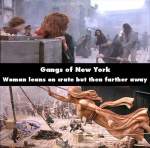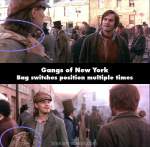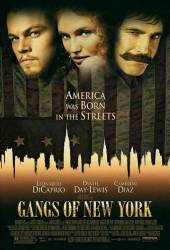Factual error: In a scene set in 1862 or 1863 Bill the Butcher says: 'An Irishman will do for a nickel what a ****** will do for a dime or a white man for a quarter'. The first nickel 5 cent piece was coined in 1866. At the time of the scene the 5 cent coin was a small silver coin called a half-dime. (01:10:00)
Factual error: In one scene where Bill is in the Mayor's office, the mayor is sitting behind his desk and holding a bunch of papers, and on the upper right hand corner of the papers is a paper clip. Paperclips were not invented until 1899. (00:21:15)
Continuity mistake: After Bill the Butcher stabs and beats Amsterdam's face badly (and brands him with a hot knife) notice how as time passes the wounds heal then reappear in varying degrees of severity. This is particularly true with the branding, which is almost absent by the end.
Factual error: When the Lords and posh folk are playing snooker they are using plastic tipped cues with blue chalk on the tip. These would not have been used in this time period. (02:15:30)
Continuity mistake: At several times during the movie, Butcher Bill's glass eye changes to what looks like a normal eye.

Factual error: When Amsterdam kills the man that shot Bill the Butcher in the shoulder at the theater, you can see bananas on the floor. Bananas were traded in the U.S. only after the Civil War. (01:13:50)

Continuity mistake: After Jenny gets mugged at the dock, the shot shows her pulling herself to a standing position on a crate. In the next shot, from farther back and up high, she is crawling over to the crate she just pulled herself up on. (02:20:55)

Continuity mistake: When Amsterdam arrives in New York City and is talking to his new friend, the bag he is holding switches from being held under his arm (camera shot from front) to being carried on his back (camera shot from the back). This happens at least four times in a row during the same scene. (00:22:55)
Other mistake: Towards the end of the movie, when the mobs are breaking into stores/houses, the police come to try and stop them. The mob starts to throw rocks at the police. You can see one of these rocks, which look like they should be heavy, bounce right off of one of the officers' heads, and just bounce around as it hits the ground, like it weighs nothing at all. (02:14:30)
Other mistake: When Bill, Amsterdam and Tweed are standing on the docks, Bill mentions his father died in battle in 1814, 49 years before the movie takes place. Later, Bill tells Amsterdam that he's 47 years old. That means Bill's father died before he could have been conceived.
Continuity mistake: As someone pointed out earlier, the poster for the commemoration of the Five Points battle claims to be the 16th anniversary, but the date shows 1863 -- 17 years after the 1846 battle. To further add to the confusion, when William Cutting is talking to Amsterdam in the bedroom after the night at the brothel, he says, "I killed the last honorable man [Priest Vallon] 15 years ago [in the Five Points battle]." So which is it? 15, 16, or 17 years? (00:02:42)
Continuity mistake: The amount and position of the blood on Amsterdam's neck changes during the first fight with Jenny after he discovers she's a turtledove. (00:49:05)
Continuity mistake: At their first encounter after Amsterdam's return to New York, Bill asks him to come closer. Amsterdam comes around the post he was leaning on, then the camera cuts to Priest Vallon's picture, and when Bill says it's close enough you see Amsterdam coming around the same post again. (00:35:15)
Revealing mistake: The scene where Amsterdam and Jenny are in the room together above the tavern, shortly after Bill's assassination attempt, Amsterdam pushes Jenny up against a 12 inch by 12 inch wooden beam. The problem is when he is pushing her up against this beam, you can see it flexing with the weight. Then Amsterdam is holding the beam, you can see that the beam is some type of cloth because the slight touch of his hand makes it dent in. (01:20:45)
Revealing mistake: When Jenny gets mugged at the docks, a thug hits her in the stomach with a large wooden club. The club is obviously rubber, as it bends almost ninety degrees after hitting Jenny. (00:58:20)
Revealing mistake: In the scene where Bill has Amsterdam on the table, he begins headbutting him. You don't even have to look closely to see that Amsterdam's head is obviously just a dummy head with hair sewn on it. You can even see Bill headbutting it, and the head bends a significant amount, just like rubber. If it were Amsterdam's actual head his skull would be shattered in several places and he'd be killed instantly.
Continuity mistake: When Amsterdam just met up with Jenny after she stole from the house, he is holding a handkerchief to his neck were he was cut. Then the camera view changes and his arm isn't there and it was too quick for him to move his arm. (00:50:20)
Revealing mistake: In the first fight scene, Priest Vallon stabs a man from behind with his sword. You see the sword go under his arm where he holds it there.
Continuity mistake: When Monk gives an election speech we see Amsterdam and his buddies standing at a distance in front of a house. When the camera angle changes in mid-sentence Amsterdam is standing in the first row of the audience. (02:05:25)
Factual error: In the funeral procession scene, the priest is wearing the maniple on the wrong arm. The maniple is a 2 ft strip of ornate cloth prescribed for use in the Catholic Mass before Vatican II in the early 1960s. It is actually worn of the left forearm; however, in this scene it is on the priest's right. (00:49:10)






Answer: Well, rather obviously, Amsterdam hates him because he killed his father. I mean, wouldn't you? It hardly matters that the fight was fair and that Bill showed respect about it, Amsterdam's not exactly likely to turn round, say "oh, that's alright then" and walk away. William Cutting (or William Poole, as he was in reality) was a ruthless, vicious man, who pretty much stopped at nothing to cement his control of the area. Whether he was actually worse than many of the others is questionable, but the film is based on Amsterdam's view of things - in that view, Bill is the enemy and we're supposed to see him as such.
Tailkinker ★